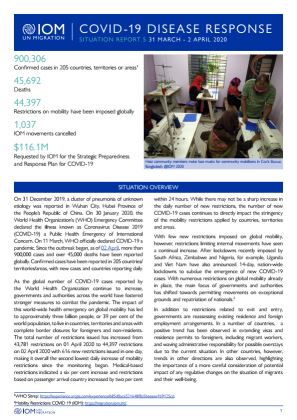-
Countries
-
Data and Analysis
-
Special Focus
-
Crisis Responses
Covid-19 Disease Response - Situation Report 5 (31 March - 2 April 2020)

Contacter
COVID Response HQ covid19ops@iom.int
Langue
English
Emplacement
Global
Période couverte
Mar 31 2020
Apr 02 2020
Activité
- Other
On 31 December 2019, a cluster of pneumonia of unknown etiology was reported in Wuhan City, Hubei Province of the People’s Republic of China. On 30 January 2020, the World Health Organization’s (WHO) Emergency Committee declared the illness known as Coronavirus Disease 2019 (COVID-19) a Public Health Emergency of International Concern. On 11 March, WHO officially declared COVID-19 a pandemic. Since the outbreak began, as of 02 April, more than 900,000 cases and over 45,000 deaths have been reported globally. Confirmed cases have been reported in 205 countries/ territories/areas, with new cases and countries reporting daily. As the global number of COVID-19 cases reported by the World Health Organization continue to increase, governments and authorities across the world have fostered stronger measures to combat the pandemic. The impact of this world-wide health emergency on global mobility has led to approximately three billion people, or 39 per cent of the world population, to live in countries, territories and areas with complete border closures for foreigners and non-residents. The total number of restrictions issued has increased from 43,781 restrictions on 01 April 2020 to 44,397 restrictions on 02 April 2020 with 616 new restrictions issued in one day, making it overall the second lowest daily increase of mobility restrictions since the monitoring began. Medical-based restrictions indicated a six per cent increase and restrictions based on passenger arrival country increased by two per cent within 24 hours. While there may not be a sharp increase in the daily number of new restrictions, the number of new COVID-19 cases continues to directly impact the stringency of the mobility restrictions applied by countries, territories and areas. With few new restrictions imposed on global mobility, however, restrictions limiting internal movements have seen a continual increase. After lockdowns recently imposed by South Africa, Zimbabwe and Nigeria, for example, Uganda and Viet Nam have also announced 14-day, nation-wide lockdowns to subdue the emergence of new COVID-19 cases. With numerous restrictions on global mobility already in place, the main focus of governments and authorities has shifted towards permitting movements on exceptional grounds and repatriation of nationals.2 In addition to restrictions related to exit and entry, governments are reassessing existing residence and foreign employment arrangements. In a number of countries, a positive trend has been observed in extending visas and residence permits to foreigners, including migrant workers, and waving administrative responsibility for possible overstays due to the current situation. In other countries, however, trends in other directions are also observed, highlighting the importance of a more careful consideration of potential impact of any regulative changes on the situation of migrants and their well-being. The aim of IOM’s COVID-19 activities, in line with the overall objective of IOM's COVID-19 Global Strategic Preparedness and Response Plan, is to support countries, and affected populations, that may need additional resources – financial, technical or operational – for preparedness or response efforts to help ensure further infections are prevented, and to assist health systems so they have the capacity to cope with COVID-19 from a mobility perspective. In addition, efforts are directed towards mobilizing the attention to more longer-term issues such as the broader socio-economic impact of the on-going crisis and economic disruptions on the situation of migrants, their communities and broader societies.
